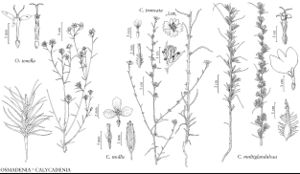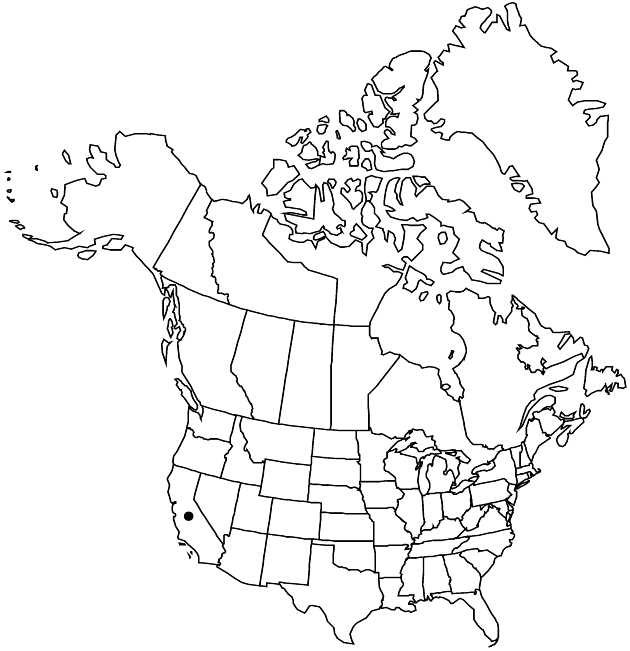Difference between revisions of "Calycadenia multiglandulosa"
in A. P. de Candolle and A. L. P. P. de Candolle, Prodr. 5: 695. 1836.
FNA>Volume Importer |
imported>Volume Importer |
||
| (6 intermediate revisions by 2 users not shown) | |||
| Line 1: | Line 1: | ||
{{Treatment/ID | {{Treatment/ID | ||
|accepted_name=Calycadenia multiglandulosa | |accepted_name=Calycadenia multiglandulosa | ||
| − | |accepted_authority= | + | |accepted_authority=de Candolle |
|publications={{Treatment/Publication | |publications={{Treatment/Publication | ||
|title=in A. P. de Candolle and A. L. P. P. de Candolle, Prodr. | |title=in A. P. de Candolle and A. L. P. P. de Candolle, Prodr. | ||
|place=5: 695. 1836 | |place=5: 695. 1836 | ||
|year=1836 | |year=1836 | ||
| + | }} | ||
| + | |special_status={{Treatment/ID/Special_status | ||
| + | |code=F | ||
| + | |label=Illustrated | ||
| + | }}{{Treatment/ID/Special_status | ||
| + | |code=E | ||
| + | |label=Endemic | ||
}} | }} | ||
|basionyms= | |basionyms= | ||
| Line 11: | Line 18: | ||
|name=Calycadenia hispida | |name=Calycadenia hispida | ||
|authority=(Greene) Greene | |authority=(Greene) Greene | ||
| − | }}{{Treatment/ID/Synonym | + | |rank=species |
| + | }} {{Treatment/ID/Synonym | ||
|name=Calycadenia hispida subsp. reducta | |name=Calycadenia hispida subsp. reducta | ||
|authority=D. D. Keck | |authority=D. D. Keck | ||
| − | }}{{Treatment/ID/Synonym | + | |rank=subspecies |
| + | }} {{Treatment/ID/Synonym | ||
|name=Calycadenia multiglandulosa subsp. bicolor | |name=Calycadenia multiglandulosa subsp. bicolor | ||
|authority=(Greene) D. D. Keck | |authority=(Greene) D. D. Keck | ||
| − | }}{{Treatment/ID/Synonym | + | |rank=subspecies |
| + | }} {{Treatment/ID/Synonym | ||
|name=Calycadenia multiglandulosa subsp. cephalotes | |name=Calycadenia multiglandulosa subsp. cephalotes | ||
|authority=(de Candolle) D. D. Keck | |authority=(de Candolle) D. D. Keck | ||
| − | }}{{Treatment/ID/Synonym | + | |rank=subspecies |
| + | }} {{Treatment/ID/Synonym | ||
|name=Calycadenia multiglandulosa subsp. robusta | |name=Calycadenia multiglandulosa subsp. robusta | ||
|authority=D. D. Keck | |authority=D. D. Keck | ||
| + | |rank=subspecies | ||
}} | }} | ||
|hierarchy=Asteraceae;Asteraceae tribe Heliantheae;Asteraceae (tribe Heliantheae) subtribe Madiinae;Calycadenia;Calycadenia multiglandulosa | |hierarchy=Asteraceae;Asteraceae tribe Heliantheae;Asteraceae (tribe Heliantheae) subtribe Madiinae;Calycadenia;Calycadenia multiglandulosa | ||
| Line 38: | Line 50: | ||
|elevation=50–1000 m | |elevation=50–1000 m | ||
|distribution=Calif. | |distribution=Calif. | ||
| − | |discussion=<p>Calycadenia multiglandulosa is found in the Coast Range from Sonoma and mid-Napa counties to San Mateo, Santa Clara, and Monterey counties and in the Sierra Nevada foothills from southern Butte and Yuba counties to Tulare County.</p><!-- | + | |discussion=<p><i>Calycadenia multiglandulosa</i> is found in the Coast Range from Sonoma and mid-Napa counties to San Mateo, Santa Clara, and Monterey counties and in the Sierra <i>Nevada</i> foothills from southern Butte and Yuba counties to Tulare County.</p><!-- |
| − | --><p>Some populations of the variable Calycadenia multiglandulosa (especially the “robusta” forms) appear to approach C. spicata in certain characters. The most striking similarity involves presence of narrower peduncular bracts with ± cylindric and truncate tips; the same specimens retain distinct characteristics of C. multiglandulosa, such as multiple tack-glands on peduncular bracts (as opposed to single terminal glands in C. spicata), considerable reduction in overall glandularity, reduced presence of hairs on cypselae (especially rays), and fewer long hairs on the abaxial faces of the phyllaries and paleae (subspp. bicolor, cephalotes, and robusta, and C. hispida including subsp. reducta).</p> | + | --><p>Some populations of the variable <i>Calycadenia multiglandulosa</i> (especially the “robusta” forms) appear to approach <i>C. spicata</i> in certain characters. The most striking similarity involves presence of narrower peduncular bracts with ± cylindric and truncate tips; the same specimens retain distinct characteristics of <i>C. multiglandulosa</i>, such as multiple tack-glands on peduncular bracts (as opposed to single terminal glands in <i>C. spicata</i>), considerable reduction in overall glandularity, reduced presence of hairs on cypselae (especially rays), and fewer long hairs on the abaxial faces of the phyllaries and paleae (subspp. bicolor, cephalotes, and robusta, and <i>C. hispida</i> including subsp. reducta).</p> |
|tables= | |tables= | ||
|references= | |references= | ||
| Line 48: | Line 60: | ||
-->{{#Taxon: | -->{{#Taxon: | ||
name=Calycadenia multiglandulosa | name=Calycadenia multiglandulosa | ||
| − | + | |authority=de Candolle | |
| − | |authority= | ||
|rank=species | |rank=species | ||
|parent rank=genus | |parent rank=genus | ||
| Line 62: | Line 73: | ||
|publication title=in A. P. de Candolle and A. L. P. P. de Candolle, Prodr. | |publication title=in A. P. de Candolle and A. L. P. P. de Candolle, Prodr. | ||
|publication year=1836 | |publication year=1836 | ||
| − | |special status= | + | |special status=Illustrated;Endemic |
| − | |source xml=https:// | + | |source xml=https://bitbucket.org/aafc-mbb/fna-data-curation/src/2e0870ddd59836b60bcf96646a41e87ea5a5943a/coarse_grained_fna_xml/V19-20-21/V21_670.xml |
|tribe=Asteraceae tribe Heliantheae | |tribe=Asteraceae tribe Heliantheae | ||
|subtribe=Asteraceae (tribe Heliantheae) subtribe Madiinae | |subtribe=Asteraceae (tribe Heliantheae) subtribe Madiinae | ||
Latest revision as of 21:13, 5 November 2020
Plants 10–70 cm; self-incompatible. Stems simple or branched (branches diffuse, relatively short, bracted), hirsutulous to strigose, often ± pilose, often glandular, especially distally. Leaves mostly alternate, sometimes opposite to beyond midstems, 3–8 cm, ± hispidulous and ± long-hairy (especially margins and adaxial faces). Heads borne singly or in spiciform (often congested) arrays. Peduncular bracts (often reddish) usually narrowly lanceolate, sometimes narrowed and ± cylindric toward apices, 4–20 mm hispidulous, ± bristly, especially along margins, ± glandular, apices acute, rounded, or truncate, tack-glands usually 2–6+. Phyllaries (± reddish) 4–10 mm, abaxial faces hispidulous, often with long bristles, shaggy long-hairy, especially distally and along margins, glandular, tack-glands (0–)l–15+. Paleae 4–10 mm. Ray florets 2–6; corollas white or cream to rose, or yellow, tubes ca. 3 mm (papillate), laminae 5–10 mm (central lobes smaller than laterals, symmetric, widest at bases, laterals strongly asymmetric, sinuses usually 1/3–1/2 laminae). Disc florets 4–20: corollas white or cream to rose, or yellow, 6–10 mm. Ray cypselae ca. 2.5 mm, smooth, glabrous or ± appressed-hairy. Disc cypselae ca. 2.5 mm, nearly smooth to ± appressed-hairy; pappi of ca. 11 lanceolate-aristate scales ca. 2.5–4.5 mm (2–3 shorter, blunt). 2n = 12.
Phenology: Flowering spring–fall.
Habitat: Dry, open valleys, hillsides, rocky ridges
Elevation: 50–1000 m
Discussion
Calycadenia multiglandulosa is found in the Coast Range from Sonoma and mid-Napa counties to San Mateo, Santa Clara, and Monterey counties and in the Sierra Nevada foothills from southern Butte and Yuba counties to Tulare County.
Some populations of the variable Calycadenia multiglandulosa (especially the “robusta” forms) appear to approach C. spicata in certain characters. The most striking similarity involves presence of narrower peduncular bracts with ± cylindric and truncate tips; the same specimens retain distinct characteristics of C. multiglandulosa, such as multiple tack-glands on peduncular bracts (as opposed to single terminal glands in C. spicata), considerable reduction in overall glandularity, reduced presence of hairs on cypselae (especially rays), and fewer long hairs on the abaxial faces of the phyllaries and paleae (subspp. bicolor, cephalotes, and robusta, and C. hispida including subsp. reducta).
Selected References
None.

